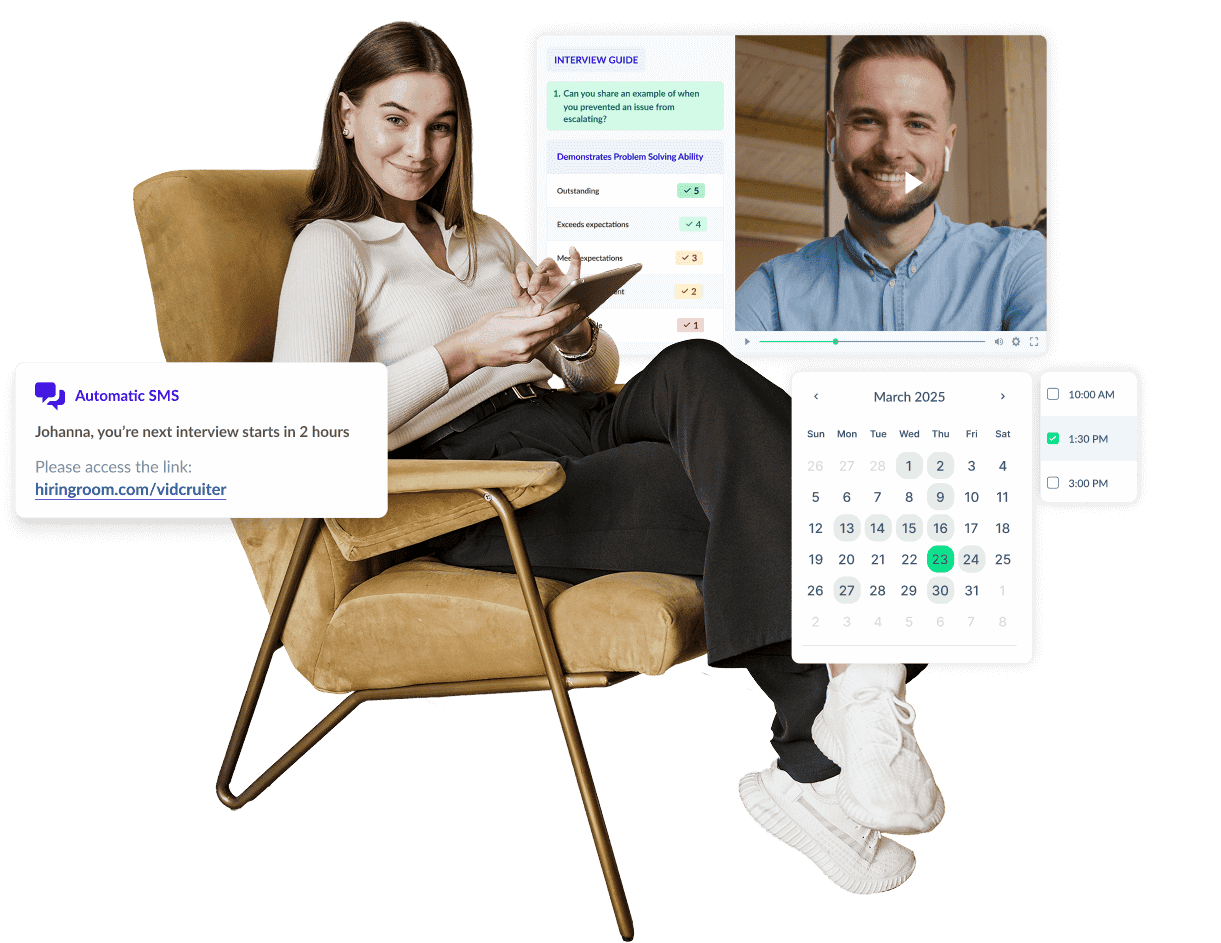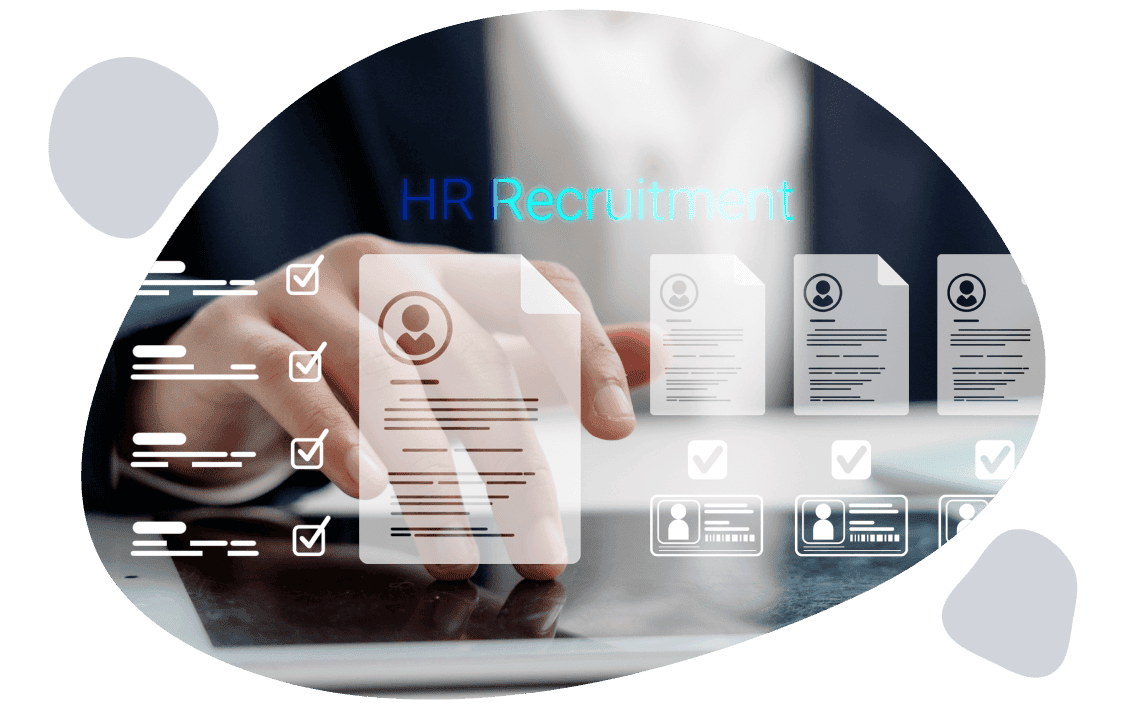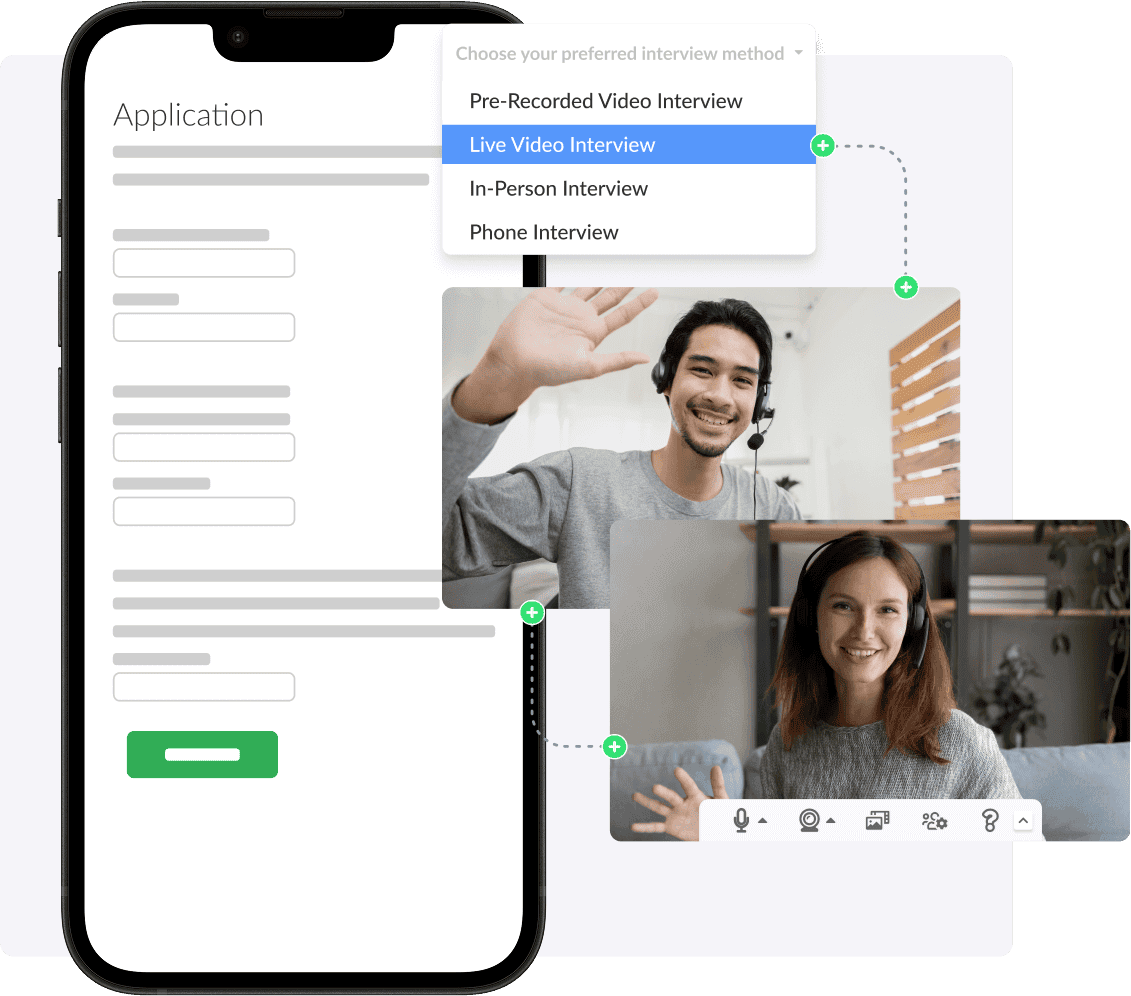
Ultimate Guide to Video Interview Software
A comprehensive overview of video interviewing software and AI-powered features designed to streamline the hiring process for recruiters and candidates.
Written by
VidCruiter Editorial TeamReviewed by
VidCruiter Editorial TeamLast Modified
Oct 15, 2025
TL;DR: Interviewing Software & Platforms: The Complete Guide for Modern Hiring

Hiring today is more complex than ever. Recruiters are managing higher volumes of applicants, balancing remote and hybrid teams, and working under stricter compliance requirements. At the same time, candidates expect a smooth, modern experience that reflects well on an organization’s brand. For many HR leaders, these competing pressures make the interview stage one of the most challenging aspects of the hiring process to manage.
That’s where interviewing software comes in. Instead of juggling calendars, video conferencing links, and scattered feedback forms, these platforms bring everything into one place. From scheduling interviews to collecting structured evaluations, interviewing software is designed to reduce administrative work, improve candidate experience, and help teams hire more efficiently.
In this guide, we’ll explore what interviewing software is, why it has become essential for modern hiring, and how to evaluate platforms for your organization. You’ll see how leading tools compare, identify the most important features, and learn how to build a scorecard for selecting the right solution. We’ll also examine real-world case studies of how organizations are utilizing platforms like VidCruiter to save time, scale their hiring processes, and create more equitable candidate experiences.
Whether you’re just beginning to explore interviewing platforms or you’re narrowing down your shortlist, this guide will provide the context and criteria you need to make an informed decision.

When evaluating interviewing software, look for:
By keeping these criteria front of mind, you’ll be better equipped to select software that supports your recruiters, engages candidates, and scales with your business needs.
Interviewing software is a type of HR technology that helps organizations manage the interview process more efficiently. Instead of handling scheduling, video calls, evaluations, and candidate communication across different systems, interviewing software brings these steps together in one platform.
With interviewing software, hiring teams can:
Many platforms also offer accessibility features such as mulitlingual support, practice questions, or phone dial-in options, ensuring that every candidate can fully participate. For recruiters, this reduces administrative work, keeps the process organized, and helps them focus on making better hiring decisions.
In short, interviewing software is designed to make hiring scalable, consistent, and candidate-friendly. It provides the structure and tools recruiters need to handle growing application volumes while maintaining a positive experience for every applicant.
Hiring has grown far more complex in recent years. Recruiters are managing higher volumes of applicants, stricter compliance requirements, and candidates who expect a seamless experience at every stage of the process. Traditional tools, such as email, calendars, and generic video conferencing, struggle to keep pace with this reality.
Recruiters are feeling the strain. LinkedIn recently reported that application volumes have surged by more than 45%, with roughly 11,000 job submissions every minute. At the same time, research indicates that approximately one in four candidates drop out during the interview stage. These numbers highlight the scale and attrition challenges that traditional tools weren’t built to handle.
One major challenge is scale. Application volumes are rising across industries, with many organizations receiving hundreds or even thousands of applicants for a single role. Managing that pipeline without a dedicated interview management system often results in delays, scheduling conflicts, and inconsistent candidate evaluations. An interviewing platform provides the structure to handle these high volumes without sacrificing fairness or efficiency.
Compliance is another growing pressure point. From GDPR and SOC 2 to ADA and WCAG accessibility standards, companies are expected to safeguard candidate data and ensure equitable hiring processes. Interviewing platforms are designed with these requirements in mind, giving HR leaders confidence that their practices meet both legal obligations and internal DEI commitments.
Beyond compliance and scale, there’s the issue of efficiency. Recruiters spend countless hours coordinating calendars, sending reminders, and following up with feedback from interviewers. An interviewing platform automates much of this administrative work. Features like built-in scheduling, automated reminders, and structured feedback forms free recruiters to focus on what matters most: engaging with top candidates.
Finally, there’s the candidate experience. Today’s applicants expect hiring to be mobile-friendly, accessible, and consistent. Interviewing platforms help deliver that experience by offering no-download video links, practice questions, and multilingual support. These features reduce candidate drop-off and strengthen the company’s employer brand.
In short, organizations need interviewing platforms because they provide a foundation for modern hiring, offering scalable processes, built-in compliance, time-saving automation, and an improved candidate journey. For HR leaders facing mounting pressure to hire quickly and fairly, these platforms are no longer a nice-to-have.

The market for interview software has grown rapidly, providing organizations with a wide range of tools to choose from. Each platform takes a slightly different approach to solving common hiring challenges, ranging from streamlining scheduling to enhancing candidate accessibility and integrating more deeply with existing HR systems.
To help you see those differences at a glance, we’ve put together a side-by-side comparison of seven leading platforms: VidCruiter, HireVue, Spark Hire, InterviewStream, Willo, myInterview, and Jobma. The table highlights interview formats, automation features, compliance standards, integration options, and candidate experience. All these factors significantly influence the buying decision.
Some platforms prioritize enterprise-grade compliance and integrations, while others focus on simplicity, affordability, and ease of use. By reviewing these details together, you can more easily determine which solution best suits your hiring team’s scale, budget, and long-term goals.
Platform
Interview Types Supported
AI & Automation
Compliance & Accessibility
Integrations & Branding
Candidate Experience
VidCruiter
One-way and live video, audio-only option, built-in scheduling
AI summaries, workflow automation, smart scheduling
GDPR, CCPA, PIPEDA, SOC 2, ISO 27001; WCAG 2.1 AA; phone dial-in option.
Works out-of-the-box with leading ATS platforms like iCIMS, Greenhouse, and Workday, plus calendar syncing (Google, Outlook) and extensibility through APIs/Zapier.
Multilingual, 24/7 support, no downloads required, optional practice questions, consistent structured interviews
HireVue
One-way and live video, scheduling, and chatbot for screening
AI-powered scoring, interview builder, virtual assistant for scheduling and FAQs
GDPR, SOC 2, ISO 27001, FedRAMP; WCAG 2.1 AA with ADA accommodations.
Major ATS integrations (Workday, Taleo, iCIMS); branded candidate portals and videos
Mobile-friendly, consistent structured interviews, accessible with accommodations
Spark Hire
One-way and live video, calendar-based scheduling
Basic automations (auto-recording, email triggers), human-driven evaluations
GDPR compliant; SOC 2 audits; accessibility widget aligns with WCAG.
40+ ATS integrations (Greenhouse, Lever, Workable), branded interfaces
Very user-friendly, no downloads, quick candidate setup, responsive support
InterviewStream
One-way and live video, interview builder, and scheduling
AI-assisted question bank, reminders, analytics dashboards
GDPR and SOC 2; accessibility via prep tools and tech checks
ATS and calendar integrations, branding for portals/emails
Practice recordings, clear guided prompts, good for education / government hiring
Willo
Asynchronous video, plus audio or text responses; basic scheduling
Minimal AI; bulk invites, reminders, Zapier automations
GDPR and ISO 27001; WCAG 2.0; supports audio/text responses
Zapier/API integrations, enterprise white-label options
Simple, flexible UX, no downloads, quick rollout; free tier available
myInterview (Taira)
One-way video plus AI chatbot for interactive Q&A, scheduling
AI chatbot evaluates text/video, automated scheduling, and candidate scoring
GDPR, SOC 2, ISO; screen reader support
API and Teams integrations, branded invites, and portals
Conversational chatbot interface, re-record options, and automated feedback to candidates
Jobma
One-way and live video, written answers, coding tests, and scheduling
AI-driven interviews, voice analytics, resume scoring, and proctoring
GDPR, CCPA, SOC 2, ISO 27001; multilingual and mobile accessibility
ATS integrations (Greenhouse, SmartRecruiters, Taleo), Zapier workflows
Clear branded portals, practice options, 24/7 live candidate support, and fairness-focused
When HR leaders evaluate interviewing platforms, they’re looking for more than just video capability. The best tools solve end-to-end hiring challenges, from scheduling and compliance to AI-powered insights. Here are the features that belong on any scorecard:
Integrations
Interviewing software doesn’t live in a vacuum. Look for platforms that integrate seamlessly with your applicant tracking system (ATS), HRIS, and calendar tools. Native integrations minimize manual data entry and reduce the risk of lost information. Open APIs or Zapier connections are also valuable if you need flexibility to connect with niche systems.
Compliance and Security
Compliance is non-negotiable for enterprise hiring. Ensure the software meets data privacy and security standards, such as GDPR, SOC 2, ISO 27001, or CCPA, depending on your geographical location. Accessibility compliance, such as WCAG standards or ADA accommodations, should also be included on the scorecard. Tools that make interviews fair and inclusive protect your brand and reduce legal risk.
Automation
Automation reduces the burden on recruiters and creates a smoother candidate journey. Key automation features include reminders, time zone adjustments, automated evaluation forms, and AI-assisted summaries or transcripts. The right balance of automation can save hours per hire and help hiring teams stay consistent.
AI Features
AI has become a defining aspect of modern interviewing software. Some platforms generate AI interview notes, transcripts, or candidate summaries, while others rely on it for scoring or ranking applicants. It’s important to understand both how AI is used and what guardrails exist around fairness, transparency, and compliance with emerging regulations.
Interview Scheduling
Scheduling is often the most time-consuming aspect of the interview process. Look for tools with built-in scheduling that sync directly with recruiter and candidate calendars. Features like self-scheduling, rescheduling options, and smart reminders can dramatically reduce no-shows and back-and-forth communication.
Candidate Experience
A good platform doesn’t just help recruiters; it makes the process easier for candidates. Prioritize mobile-friendly recruiting, no-download interview links, practice questions, and multilingual support. Candidate support features (like phone dial-in or 24/7 help) can reduce drop-off rates and keep your employer brand strong.
Customization and Branding
Employer branding matters in every touchpoint with candidates. Strong platforms let you customize logos, colors, welcome videos, and communication templates so candidates experience a seamless, professional process from start to finish.
Scalability
Finally, consider how well the software will handle growth. Tools that work well for a small team may break down under the pressure of hundreds of interviews. Evaluate whether the platform can handle increasing application volumes, manage interviewer collaboration, and provide reporting that scales with your hiring needs.

A common question HR leaders ask is, “Why can’t we just use the tools we already have?" After all, platforms like Zoom, Google Meet, and Calendly make it possible to schedule and conduct interviews. On the surface, they accomplish their tasks. However, upon closer examination, these general-purpose tools introduce friction and hidden costs that increase as hiring scales.
Scheduling across teams becomes a headache. Coordinating multiple calendars often requires premium scheduling tools, and recruiters still end up manually updating candidate records in the ATS. When updates aren’t logged in the ATS, duplication can cause real problems: interviews get missed, candidates fall through the cracks, or multiple recruiters contact the same person.
Interviews lack structure. Video conferencing tools are great for meetings, but they don’t provide interview-specific features, such as scoring rubrics, guided evaluation forms, or automated reminders. Recruiters have to patch together their own processes, which makes maintaining consistency across large hiring teams difficult.
Built for meetings, not hiring compliance. Hiring today means meeting strict standards for data security and candidate accessibility. Tools like Zoom now carry certifications such as SOC 2, ISO 27001, and GDPR compliance, but they were not built with hiring workflows in mind. HR teams often require additional steps to manage evaluation structures, compliance audits, and fairness requirements, which adds complexity and potential risk compared to a dedicated interviewing platform.
Candidate experience suffers. Generic tools often require downloads, don’t account for time zones, and lack features like practice questions or mobile-friendly access. These friction points can contribute to higher candidate drop-off at a time when every qualified applicant matters.
Specialized interviewing platforms address these challenges by integrating scheduling, evaluation, automation, and compliance into a single system. The difference isn’t whether you can technically run an interview on Zoom, because you can, but whether that process will scale, stay compliant, and deliver a positive candidate experience. For most organizations, investing in a platform specifically designed for hiring is the most effective way to keep pace with modern recruiting demands.

VidCruiter consistently helps hiring teams across various industries save time, scale their operations, and deliver a better candidate experience. Below are three highlighted case studies that demonstrate how VidCruiter solutions, ranging from automated reference checks to structured video interviewing, drive tangible impact.
When this leading Canadian health services provider needed a faster and more compliant hiring process, VidCruiter’s automated reference checks made a significant difference. Medavie Blue Cross successfully conducted over 1,800 reference checks, saving nearly 1,000 hours annually, while maintaining high standards for accuracy and fairness.
Sheridan College processes around 40,000 applicants each year. This is a high-volume challenge made manageable thanks to VidCruiter’s suite of pre-recorded interviews, structured digital assessments, skills testing, and reference checks. The result? Thousands of hours saved across the recruiting team, with greatly improved process consistency.
Paymentsense, a fast-growing fintech company, needed to streamline its hiring to keep up with business growth. Using VidCruiter’s pre-recorded video interviews, the company reduced time-to-hire while ensuring candidates had a smoother experience. The ability to review recorded responses at their own convenience also provided hiring managers with more flexibility and enhanced collaboration across teams.
For many organizations, the interview stage is where bottlenecks often appear: scheduling takes too long, interviewers struggle to provide consistent feedback, and candidates lose momentum. The right interviewing platform helps remove these barriers. By approaching the buying process methodically, HR leaders can ensure they invest in a tool that saves time and supports better hiring outcomes.
Step 1: Understand your pain points
The process begins with taking a close look at your current hiring workflow. Where are the bottlenecks? Recruiters often cite scheduling, inconsistent evaluations, or manual data entry into the ATS as pain points. Candidates may point to confusing processes, a lack of communication, or difficulty accessing interviews. Speak with recruiters, candidates, and recent hires to understand where your specific process is falling short.
Quantify these issues wherever possible. For example:
Establishing a baseline helps you measure the impact of any platform you consider.
Step 2: Build a scorecard
Once you understand your challenges, create an evaluation scorecard. This framework ensures that every platform is judged against the same criteria rather than being swayed by flashy demos. Common categories include:
Weigh these categories based on your priorities. A global enterprise may give compliance the most weight, while a growing startup may prioritize ease of use and affordability.
Step 3: Involve key stakeholders
Interviewing software doesn’t just impact recruiters. Hiring managers need easy ways to evaluate candidates, IT and security teams must be confident in compliance, and DEI leaders will want assurance that the platform supports fairness and accessibility.
Engage these groups early in the process. Gather their requirements and use them to refine your scorecard. This not only ensures you choose a platform that meets everyone’s needs but also builds buy-in across the organization.
Step 4: Research & shortlist vendors
With your scorecard in hand, start researching potential vendors. Look at analyst reviews, HR technology blogs, and recommendations from peers. Create a shortlist of three to five platforms that align with your criteria.
Keeping the list concise helps prevent demo fatigue while providing a range of options to compare. At this stage, it’s also worth noting pricing models. Some vendors charge per user, while others scale based on the volume of interviews.
Step 5: Demo and validate through real use cases
Demos help you get more specific information from your shortlisted vendors. Don’t just sit through a standard sales pitch. Ask vendors to walk through scenarios specific to your team. For example:
If you need to see more after your initial demo, you can request additional resources, such as a sandbox/demo environment to test the software, a group demo for your team, or a customer reference call with a company of a similar size and industry. Hearing directly from peers about what works (and what doesn’t) can be just as valuable as hands-on testing.
Step 6: Evaluate ROI and candidate experience
After demos, return to your scorecard. Which platforms best address your pain points? Consider ROI not just in dollar terms, but also in terms of recruiter time saved, candidate drop-off reduced, and compliance risk mitigated.
It’s also critical to assess the candidate experience. Would this platform make the process smoother and more accessible? Would candidates feel more engaged and respected? Remember, the hiring process is a reflection of your employer brand.
Step 7: Make a confident selection
With your research complete, choose the platform that aligns most closely with your organizational goals. The right interviewing software should not only solve today’s challenges but also position your team for long-term success.
Hiring teams today face a common set of challenges: an increasing number of candidates per role, higher compliance standards, and rising expectations from candidates. Interviewing software is designed to bring order and structure to this process, helping recruiters save time, improve the candidate journey, and ensure that every interview is consistent and compliant.
VidCruiter is built to address these realities. The platform combines robust scheduling, live and pre-recorded interviews, automated reference checks, and deep ATS integrations into one solution. Compliance and accessibility are built in from the ground up, with support for GDPR, SOC 2, and WCAG standards. For recruiters, this means a reduced administrative burden and increased focus on engaging the right candidates. For candidates, it means a seamless, professional experience that reflects positively on the employer brand.
Organizations ranging from healthcare providers to universities and financial services firms have already used VidCruiter to reduce time-to-hire, save hundreds of recruiter hours, and handle hiring volumes that would overwhelm traditional processes. Whether your team is focused on efficiency, fairness, or scalability, VidCruiter provides the structure and flexibility needed to meet modern hiring demands.
If you’re considering investing in an interviewing platform, VidCruiter offers a solution designed to empower recruiters, support candidates, and help organizations hire with confidence.

Interviewing software isn’t just for enterprise organizations. Smaller companies benefit from time savings, reduced no-shows, and a smoother candidate experience. Many platforms offer tiered pricing or lightweight packages that scale with your growth. For SMBs, these tools can eliminate scheduling headaches and give candidates a professional first impression without overloading recruiters.
Most leading platforms are built with compliance in mind. This typically includes data privacy certifications, such as GDPR, SOC 2, or ISO, as well as accessibility standards like ADA or WCAG. For HR leaders, it’s essential to verify which certifications a vendor holds and how they manage candidate data. Compliance ensures both legal protection and a fair, inclusive hiring process.
Yes, most platforms offer direct integrations with applicant tracking systems (ATS) and calendar tools, such as Outlook or Google Calendar. This ensures interviews are scheduled automatically, notes are stored in the right place, and recruiters don’t need to duplicate data entry. Integrations reduce friction and help hiring teams keep a single source of truth across their systems.
ROI often comes from a mix of recruiter hours saved, faster time-to-hire, and reduced candidate drop-off. For example, automating scheduling and reminders can free dozens of recruiter hours each month. A faster hiring process means filling roles sooner, reducing lost productivity. Compliance safeguards also lower legal risk. When measured together, these factors usually outweigh the subscription costs.
Interviewing platforms are designed to reduce friction for candidates. Features like mobile-friendly access, no-download video links, practice questions, multilingual support, and built-in reminders make the process more accessible and engaging. A smoother, more consistent experience helps candidates feel respected, improves completion rates, and strengthens your employer brand from the very first interaction.
Modernize your hiring process with expert insights and advice.